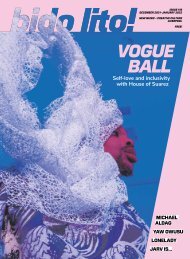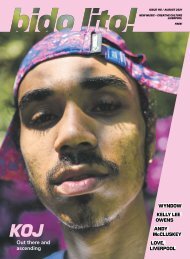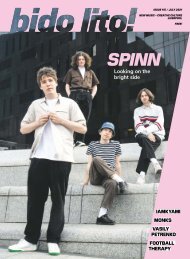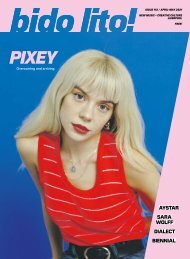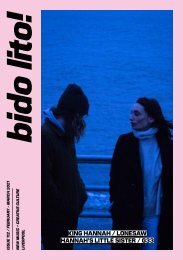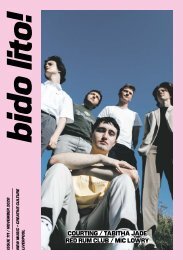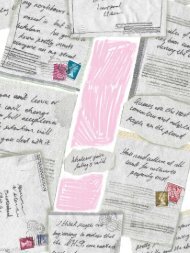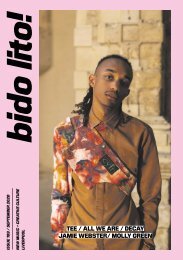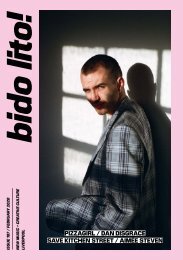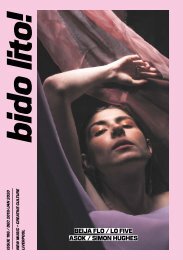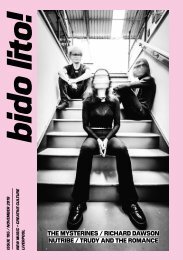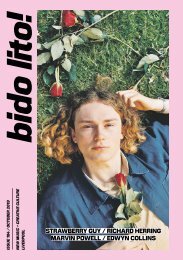Bluedot Volume1
Bluedot - a festival of discovery at Jodrell Bank | 22.23.24 July 2016. A preview magazine featuring interviews with Jean-Michel Jarre, Air, Public Service Broadcasting, Mercury Rev, The Infinite Monkey Cage and more. www.discoverthebluedot.com
Bluedot - a festival of discovery at Jodrell Bank | 22.23.24 July 2016. A preview magazine featuring interviews with Jean-Michel Jarre, Air, Public Service Broadcasting, Mercury Rev, The Infinite Monkey Cage and more. www.discoverthebluedot.com
Create successful ePaper yourself
Turn your PDF publications into a flip-book with our unique Google optimized e-Paper software.
BE – ONE<br />
T<br />
he humble bee: life-spring of nature, ruiner of<br />
picnics, coloniser of Soleros and now, ticking<br />
off some species-wide bucket list, rock star. As<br />
anyone who’s ever been in The Fall will tell you,<br />
40,000 insects can make better bandmates<br />
than some musicians and, last year, Wolfgang Buttress set<br />
out to do just that. Tasked with building a pavilion on the<br />
topic of Feeding The Planet, Energy For Life for the Expo<br />
2015 exhibition in Milan, the Nottingham-based artist<br />
decided to focus on the plight of the bee, constructing a<br />
17-metre-high latticework sculpture called The Hive.<br />
“The honey bee is responsible for 30 per cent of<br />
the food we eat but it’s in crisis because of pesticides,<br />
the lack of biodiversity and monoculture,” he explains.<br />
“Rather than express it as a spectacle I wanted to express<br />
it as an experience. Inside this structure of The Hive was<br />
linked to a real beehive back in Nottingham and inside<br />
this real beehive we put things called accelerometers,<br />
which measure vibrations. Through these vibrations they<br />
send digital signals so we know what’s happening in<br />
real time inside the colony. We know whether the hive<br />
is busy, quiet, healthy, unhealthy. I had this idea that it’d<br />
be amazing if you could send these digital signals to a<br />
sculpture over in Milan and these would be expressed as<br />
light or sound. When you’re in The Hive, you’re inside the<br />
experience, you were feeling almost what it’s like to be a<br />
bee inside a hive.”<br />
But what, went the logical thought progression, if the<br />
bees were holding a jam festival? What if they could make<br />
the bees rock? Upon first lifting open a bee frame, Buttress<br />
was met with a low, visceral drone hum akin to a honeymaking<br />
Sunn 0))), and the musical possibilities struck him.<br />
“It was really deep, this amazing drone, and you get<br />
drones in cultures all over the world, from Aborigines to<br />
Eastern European music. It was an incredible sound, so I<br />
wanted to try to express this hum.” He gathered friends<br />
and the Nottingham hive’s owner – researcher Dr Martin<br />
Bencsik of Nottingham Trent University – into a studio<br />
streaming the sound of the bees and the magic that<br />
would become the mesmerising album Be One began<br />
to spark. Bencsik’s wife Deirdre, a classically trained<br />
cellist, noted that the bees were humming in the key of C<br />
and began playing along; Wolfgang’s daughter Camille<br />
started singing accompaniment. “Really quickly we had<br />
this amazing triangle of sound,” Wolfgang recalls, “the<br />
human voice, the sound of the bees, the sound of the<br />
cello, the most amazing sound.”<br />
Experimental rock artists swarmed (as it were) to the<br />
project. When guitarist Tony Foster played the bees’<br />
music in Spiritualized’s studio, Jason Pierce offered<br />
his services on auto-harp, harmonium and guitar and<br />
helped recruit Sigur Rós’ string section Amiina to the<br />
cause. It’s a wonder no one asked noted pro-bee<br />
campaigner Liam Gallagher to get involved. “I didn’t<br />
know he was into bees,” Wolfgang says, “I’ll have to<br />
look into that!”<br />
With such star power in their backing band, the bees<br />
needed to assert their position at the top of the bill. So<br />
Buttress worked out a way they could actually play their<br />
own instruments. “We recorded a whole series of musical<br />
stems in the key of C, some violin parts, piano parts, a<br />
Mellotron, some vocals. In the Pavilion in Milan, at certain<br />
thresholds, certain frequencies, a noise gate would be<br />
opened by the energy of the bees back in Nottingham.<br />
Depending on the pitch it could be a violin, a guitar or a<br />
piano. We knew everything would be in harmony in the<br />
key of C, but it was completely fluid and fairly random<br />
in terms of human intervention. One of the most amazing<br />
things was the sense of letting go. In a way it was the<br />
bees who were choosing the symphony.”<br />
By then feeding the music the bees were making back<br />
into the hive, they created a cross-species version of<br />
Africa Express. “We think bees are virtually deaf, so we<br />
modulated some of the sounds, turned them back into<br />
vibrations, and then put an accelerometer back into the<br />
beehive to see how they would react to the music we<br />
were playing. If bees are scared or unhappy they tend<br />
to freeze, go very static and silent. But when we started<br />
playing the music back to them they started reacting<br />
back to it and you can hear some little tonal vibrations<br />
reacting to some of the music. This is the next part of the<br />
experimentation, to have this circular, almost jazz way of<br />
writing music with the bees. The sound of the bees would<br />
be played, the musicians would react to it, it’d go back<br />
into the beehive and the bees could potentially react to<br />
that, the whole thing is a circle.”<br />
“One of the most amazing things<br />
was the sense of letting go. In away<br />
it was the bees who were choosing<br />
the symphony”<br />
At bluedot, Wolfgang promises a “very immersive,<br />
slightly trippy” audio-visual<br />
experience whereby the<br />
album’s musicians play along to<br />
a live, surround-sound feed of<br />
bees accompanied by thermal<br />
images from the hive projected<br />
onto netting.<br />
Has he checked it’s not<br />
mating season? You might end<br />
up with every bee in a 10-mile<br />
radius descending on the gig.<br />
Wolfgang laughs. “That might happen, but when they<br />
do swarm, they don’t sting you. We collected a swarm<br />
recently to put them inside a cello, and they’ll swarm<br />
all over you but never sting you because the only thing<br />
they’re interested in is finding a new home or having sex.<br />
So if they do come in it’d be amazing, but they wouldn’t<br />
harm the audience.”<br />
It promises to be the buzz gig of the weekend (sorry),<br />
but what’s next for Wolfgang? The Beetles, surely? “We’re<br />
doing some stuff with the same musicians again, working<br />
with vibrations. The next one, the bass is coming from<br />
the earth, so we’re working with the national geological<br />
society, putting seismic meters into the earth to create<br />
the bass. Then we’re working with NASA on this other<br />
project where we’ve got two satellites on the sun 24-7<br />
and we’re getting signals from the flares on the sun,<br />
they’re creating the high end, the treble. The audience<br />
will be the interface between the bass of the earth and<br />
the treble from the sun.”<br />
Cosmic, dude…<br />
wolfgangbuttress.com<br />
WRITTEN BY MARK BEAUMONT<br />
ORBIT STAGE<br />
SUNDAY<br />
34 | EXPLORE




